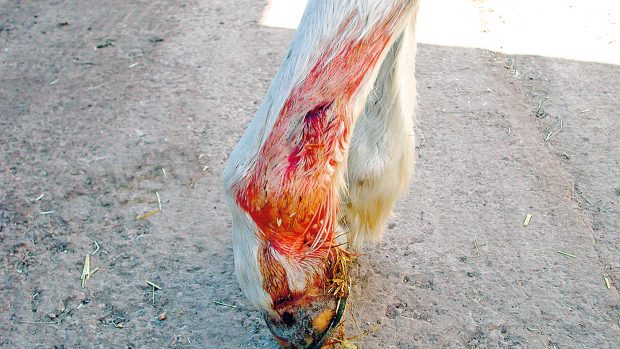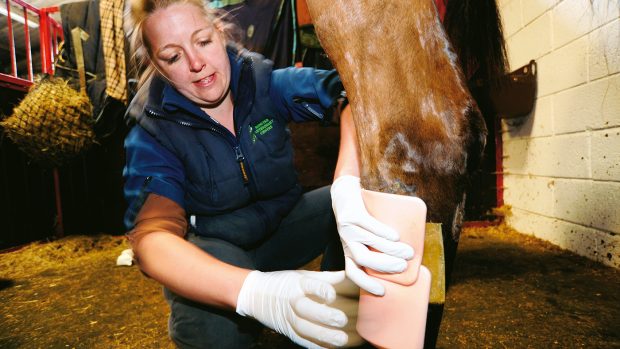If you look after horses, sooner or later you will encounter some kind of emergency which will require first aid treatment. Horses are inevitably accident-prone because their instinct is to flee from danger, often disregarding obstacles such as fences, people or vehicles.
Secondly, as herd animals, they have a “pecking order”, which means that they sustain kicks and cuts as they sort out their rank in the herd hierarchy.
Third, we ask horses to perform athletically and, as they gallop,jump and generally work hard for us, they run the risk of injury. Remarkably, more horses seem to sustain serious injury in their stable or out in the field than when competing.
Basic principles
First aid is the immediate treatment required when an injury is discovered. It may provide help straightaway for an obviously serious emergency until the vet arrives or treat minor injuries that are unlikely to need a vet. Difficulties arise with borderline cases, when it can be hard to decide the seriousness of the damage. If in doubt, consult your vet. Horse owners must know how to recognise a serious injury and how to respond with the appropriate first aid.
When a horse is cut and bleeding badly, the problem is obvious, but in cases of colic, illness or a more subtle injury, it can be hard to assess how distressed the horse actually is. It is therefore important to know your horse’s normal vital signs, including temperature, pulse and respiration, so you can easily detect any changes. Similarly, make sure you are aware of their normal behaviour patterns, so that you can spot differences.
The basic principles of managing first aid do not change, but it is always best to consider everything in advance, to avoid panic in a crisis.
This means:
- know how to contact your vet in an emergency
- know where or how you can obtain horse transport in a hurry
- keep a well-stocked first aid kit available.
Immediate aid
The most common first aid condition is when a horse sustains a wound. The immediate action should be to:
- prevent further injury
- control blood loss
- minimise contamination
- maintain cleanliness and reduce the risk of infection.
This may seem obvious, but when faced with a crisis, it may be less clear. It is important to remember that a small amount of bleeding will look colossal when it is your favourite horse.
All but the most severe bleeding can be controlled by applying a clean, dry bandage pad with moderate pressure. If you are out in the middle of nowhere, sacrifice a T-shirt or similar to hold over the wound. If you can tape it in place or hold it there for at least 5min, it should allow blood clotting to occur.
The ideal is to use a sterile or clean bandage to reduce contamination by dirt and dust. This is where dressings from a first aid kit are useful.
The first aid rules to remember with every wound are:
- clot: first stop the bleeding
- check and clean: contamination and infection prevent wounds from healing. If infection penetrates vital structures such as joints or tendon sheaths, a horse may be permanently crippled. So it is vital to check carefully the position, depth and severity of any wound. To do this properly, you will need to clean the wound, so that you can see what is involved, provided this can be done without making it bleed further.
- cover: the wound should be covered where possible to protect it. People are often tempted to apply creams and potions on to an injury. It is important to remember that raw tissues are exposed. A good guide is to never to put anything on a wound which you would not put in your eye.
Wound management
With a wound, always contact your vet if:
- any wound is bleeding profusely
- the horse is very lame, even if the wound is small
- any wound that is more than a couple of inches long and has gone right through the skin, so that it gapes open, may need stitching
- there is any suspicion of a foreign body
- there is any suspicion that a joint may be involved
- the horse has not had an anti-tetanus vaccination.
Innovations
Although wounds do not change, some recent developments such as the new water-soluble wound gels are useful. Originally designed for human burns patients, these have also been shown to be useful in horses. They can be applied to the area of damage, helping to keep the wound clean and moist. It is thought that the gels will reduce the number of bacteria in the wound and can help speedy healing.
They are a useful addition to any first aid kit and a safe and satisfactory answer to the question: how shall I cover a wound? There are various products on the market, including Derma-gel, Intrasite gel and Nugel.
Another innovation is surgical skin staples, which are now often used instead of stitching for certain types of skin wounds. They can be inserted quickly and can be ideal when a horse does not want to stand still. Staples do not work well for jagged injuries, or when the wound edges are under a lot of tension; however, they are often an efficient way torepair clean cuts.
A wound may need to be sutured if:
- the edges are gaping apart
- it is large or deep
- it is in an awkward place where it will scar.
If you think a wound may need to be sutured, you should consult your vet as soon as possible, since it will heal more effectively if it is sutured while still fresh. However, there is a 6-8hr optimum period for wound repair. Deep punctures, swollen or crushed wound edges and severely contaminated or infectedwounds will not be suitable for suturing, nor will wounds that are more than 8hr old in most cases. Your vet will advise you on this. Many wounds that look appalling at first inspection will repair well given time and proper care.
Leg support
Leg injuries are another common first aid issue. If a suspected fracture is managed properly, immediately after the initial injury, it may improve the chances of recovery.
If a horse is extremely lame, it is important to prevent itfrom moving unnecessarily on the damaged leg and exacerbating the injury. Keep the hopping-lame horse as still as possible while help is summoned. Proper immobilisation and support of the injury will help relieve pain.
Inadequate splinting can make an injury worse. With a suspected fracture, your vet may apply a large support bandage, known as a Robert Jones bandage. There are now several commercial splints available for vets to use, such as the Kimzey leg-saver splint. These or support bandages enable the horse to travel for further evaluation and treatment.
It is essential to remember that first aid is the first thing done. Most important of all is ensuring that the horse is not in pain. Treating a wound, supporting a leg injury, good nursing and the correct management as soon as something goes wrong can all speed a successful recovery.


